
The chalkhill blue is a butterfly in the family Lycaenidae. It is a small butterfly that can be found throughout the Palearctic realm, where it occurs primarily in grasslands rich in chalk. Males have a pale blue colour, while females are brown. Both have chequered fringes around their wings.

Parnassius stoliczkanus, the Ladakh banded Apollo, is a rare high-altitude butterfly which is found in Central Asia. It is a member of the snow Apollo genus (Parnassius) of the swallowtail family. It is named after the naturalist and explorer Ferdinand Stoliczka.

Polyommatus eros, the Eros blue or common meadow blue, is a species of blue butterfly found in the Palearctic.

Erebia epistygne, the spring ringlet, is a species of butterfly in the family Nymphalidae. It is found in France and Spain. Its natural habitat is temperate grassland.

The Piedmont ringlet is a member of the family Nymphalidae. It is an Alpine butterfly.
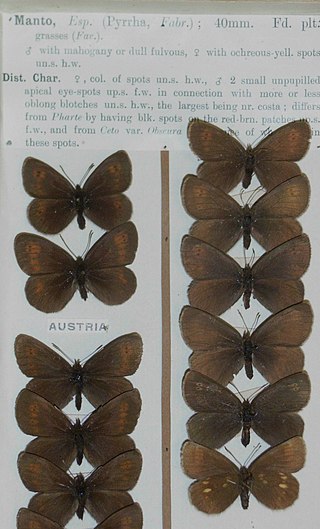
The yellow-spotted ringlet is a member of the subfamily Satyrinae of the family Nymphalidae. It is associated with (sub)alpine meadows at 900–2,500 m above sea level. It is found in the Alps, the Pyrenees, the Cantabrian Mountains, the Massif Central, the Vosges Mountains, the Carpathian Mountains and the mountains of Herzegovina.
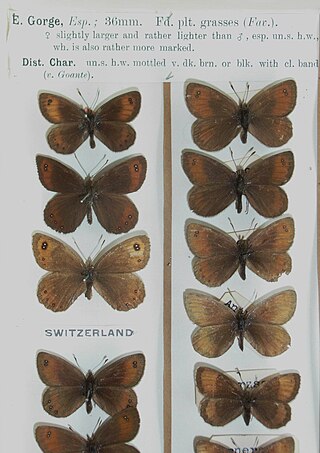
The silky ringlet is a member of the subfamily Satyrinae of the family Nymphalidae. It is a high-altitude butterfly found on screes in the Alps, Pyrenees, central Italy and the Balkans. It is a very variable butterfly.

The Styrian ringlet is a member of the subfamily Satyrinae of the family Nymphalidae. It is a mountain butterfly found in the Austrian and Italian Alps, Croatia and Slovenia.
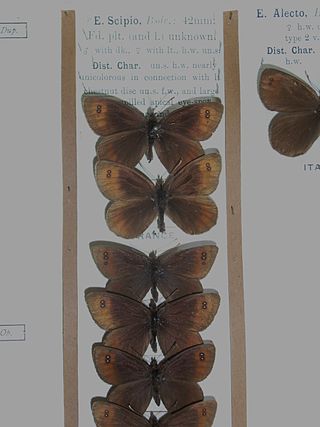
The Larche ringlet is a member of the subfamily Satyrinae of the family Nymphalidae. It is a high-mountain butterfly found in the Alps of France and Italy.
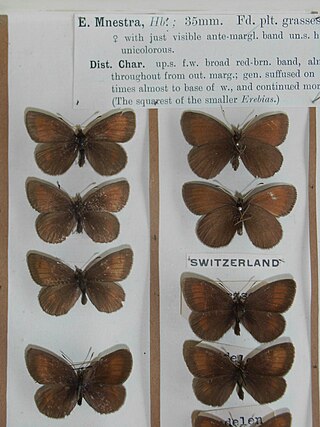
Mnestra's ringlet is a member of the subfamily Satyrinae of the family Nymphalidae. It is a mountain butterfly found in the Alps of Austria, France, Italy and Switzerland. The Mnestra's ringlet is named for Mnestra, a daughter of Erysichthon, king of Thessaly in Greek mythology.

Polyommatus damon, the Damon blue, is a butterfly of the family Lycaenidae.

Polyommatus escheri, Escher's blue, is a butterfly of the family Lycaenidae. It is found in Southern Europe and Morocco.

Boloria pales, the shepherd's fritillary, is a butterfly of the family Nymphalidae. It is found from the Cantabrian Mountains and the Pyrenees through the Alps and Apennine Mountains east to the Balkan, Carpathian Mountains, the Caucasus and central Asia up to western China.

Erebia pandrose, the dewy ringlet, is a member of the subfamily Satyrinae of the family Nymphalidae. It is found from the Arctic areas of northern Europe, the Pyrenees, Alps, the Apennine Mountains, the Carpathian Mountains, Kola Peninsula and Kanin Peninsula, part of the Ural and the Altai and Sayan Mountains up to Mongolia.

Polyommatus (Plebicula) dorylas, the turquoise blue, is a butterfly of the family Lycaenidae. It is found in southern Europe, Asia Minor, the Ural Mountains, Caucasus and Transcaucasia. Its wingspan is 15–17 mm. The butterfly's common name comes from the dazzling bright blue colour of male's wings. The larvae feed on Anthyllis vulneraria. The butterfly flies from May to September in two generations. Habitats include flowery meadows in rocky areas at 500–2000 m.

Boeberia is a genus of satyrine butterflies containing a single species Boeberia parmenio found in the Altai mountains South Siberia, Mongolia, Yakutia, Amur and North east China.
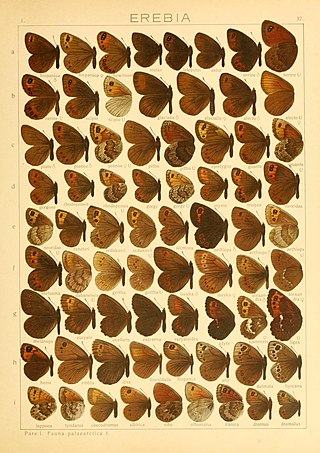
Erebia dabanensis is a small butterfly found in the East Palearctic that belongs to the browns family.

Polyommatus damone is a Palearctic butterfly in the Lycaenidae family.

Polyommatus hunza is a butterfly in the family Lycaenidae. It was described by Grigory Grum-Grshimailo in 1890. It is found in the Pamir mountains.Seitz under Polyommatus stoliczkanus- hunza Gr.-Grsh. (80) are very large specimens with almost entirely white underside, the ocelli and russet-coloured marginal spots being reduced to weak vestiges; from the Pamir.

Polyommatus venus is a butterfly in the family Lycaenidae. It was described by Otto Staudinger in 1886. The type locality is Kirghizia.




















